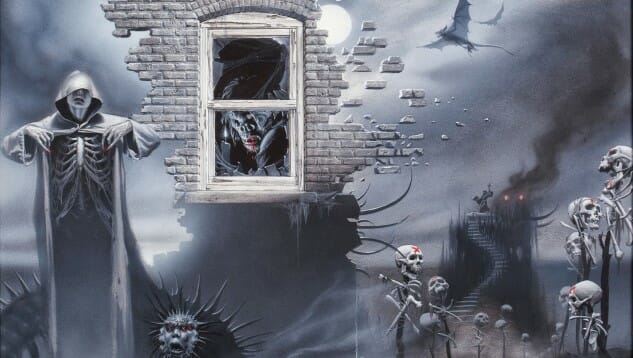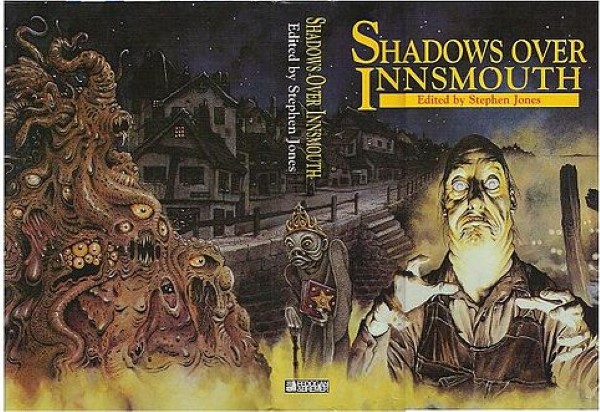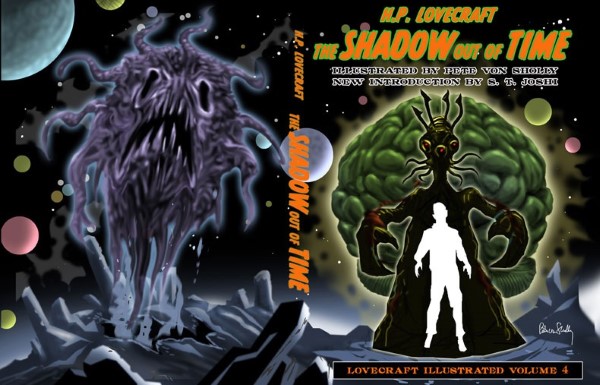Five H.P. Lovecraft Stories You Should Actually Read in 2017
Header art by Michael Whelan / Del Rey (1987)
When I was a high school student, back in the early 2000s, the world was completely unaware of Howard Phillips Lovecraft.
At least, that’s how it felt to me at the time. It isn’t true, but the name “H.P. Lovecraft” certainly had much, much less cultural cache than it does now, some 15 years later. Back then, I was just discovering the father of “cosmic horror” as part of a fascination with vintage horror fiction. I read those books of short fiction throughout high school and college courses without ever eliciting a single response of recognition. But then something odd happened—Lovecraft went mainstream.
It’s hard to say exactly when it happened. Perhaps it was videogames that helped in the transition, with titles such as Call of Cthulhu: Dark Corners of the Earth. Convention culture certainly played a large part, as did the memorabilia industry, which latched on to the iconography of some of Lovecraft’s Great Old Ones, such as Cthulhu, turning them into ironically cute “plushies” perfect for a Hot Topic or a teenage goth girl’s nightstand. And then of course there are the films, which went from being lightly based around Lovecraft works in the ‘80s (such as Re-Animator or From Beyond) to actually using the man’s name as a marketing tool—look no further than The Last Lovecraft: Relic of Cthulhu in 2009. Regardless of the reason, by the time we got to 2010, we were getting entire episodes of South Park revolving around Cthulhu and other elements of H.P. Lovecraft’s work. The general idea of Lovecraft’s stories have permeated pop culture, to the point that average people know what “Lovecraftian” implies when used as an adjective.
That’s all well and good, except for one thing: Many of the people out there who claim an appreciation of Lovecraft’s cosmic horror aesthetic have never actually read any of the original source material. The set dressing of Elder Things and Great Old Ones and Unspeakable Horrors is an attractive one, but that’s not necessarily all there is to Lovecraft’s oeuvre. The man was a curious, fascinating writer; one who was purposefully antiquated at times. He preferred archaic, dated styles of spelling and sentence construction, which was counterpointed by his startling creativity in pioneering a new style of horror story that had never truly been seen before. He lived a bleak life, died young, and never achieved any sort of fame or popularity until long after his passing. But his overall impact on modern horror writers, from Stephen King to Clive Barker, can hardly be overstated.
The question, then, is if you’ve never read any of Lovecraft’s works, which ones SHOULD you bother to tackle if you’re just exploring them for the first time in 2017? Which stories can you read that will give you a better understanding of what Lovecraft’s fiction is actually like, and why he’s been such an influence? We’ve chosen five of those stories for you below.
In doing so, you do have to confront a few things about the writer. Lovecraft was not a sociable man, nor a gregarious kind of guy. His stories frequently display backward thinking, with a near total lack of female characters, who, when they rarely appear, are typically manipulative villains. Worse is his attitude toward “lesser races,” which can only be described as overtly racist and frequently anti-semitic, and manifests itself in stories such as “Facts Concerning the Late Arthur Jermyn and His Family.” I’ve strayed away from those stories, in an effort to highlight the more valuable works of Lovecraft that are still worth reading today.
So let’s get into it. Check out these five stories, which can be found in various Lovecraft collections.

“The White Ship”
When you read the name of Lovecraft, imagery from the so-called “Cthulhu Mythos” likely swims to mind immediately. These massive, extra-dimensional monster gods are the writer’s most enduring contribution to pop culture, but not all of his work dealt with them, even remotely. In fact, most Lovecraft stories aren’t directly tied to Cthulhu, the Great Old Ones or his equally confusing pantheon of Outer Gods—they may be mentioned obliquely at some point, but primarily as portentous set dressing designed to evoke a macabre atmosphere. It’s only due to the work of Lovecraft devotees/profiteers such as writer August Derleth that the whole “pantheon” of such beings became greatly expanded and codified in ways that go far beyond Lovecraft’s vision.
“The White Ship,” on the other hand, is part of the so-called Lovecraftian “Dream Cycle,” a collection of more than 20 stories (or about one-third of all his works) that loosely take place in and around a fantastical “Dreamlands” that are accessible to mortal men via nightly dreaming by skilled dreamers. Several of these stories follow the exploits of one particularly ambitious and adventurous human dreamer named Randolph Carter, but I typically prefer the others—Carter coming off as a somewhat vain self-caricature of Lovecraft, who (accurately, but not humbly) saw himself as a man of great imagination.

“The White Ship,” on the other hand, takes place entirely within the Dreamlands, and tells the story of a lighthouse keeper who is beckoned out to a mystical white ship, where he meets the crew and sails away to strange and fantastical lands. The tale is best described as a pure fantasy, with elements of the macabre and horrific, but with a primary focus on conjuring up magnificent locales observed by our narrator as the ship’s journey rolls onward. It paints the Dreamlands as a place both wondrous and potentially maddening, which is of course a common theme in Lovecraft’s writing. It also functions as something of a parable—a warning against man’s instinctual tendency toward not being satisfied with love and beauty, but continually increasing greed for something even greater.
“The White Ship” is a beautiful story—one of Lovecraft’s prettiest without a doubt, with a somber, somewhat sorrowful tone that has true gravitas. For a man whose stories have often been caricatured as all ending with “and then he saw something unspeakable and went insane,” readers may be surprised by how poignant it is.

“The Call of Cthulhu”
Yes, you’ve probably heard the name. This is probably the most famous short story by Lovecraft, except perhaps for “The Shadow Over Innsmouth,” and it’s the original source for almost everything the man ever personally wrote about Cthulhu … which once again has been massively expanded in the years since, not by Lovecraft but by other writers such as August Derleth.
The structure of the tale is somewhat non-traditional, combining a traditional narrative with elements of epistolary; journals kept by various researchers and witnesses to the Cthulhu cult that are discovered by the narrator. It has elements of globe-trotting adventure, almost in the vein of Doc Savage, as the narrator travels around and discovers various stories of cults and secret sects all around the world that have been worshipping the long-dormant being known as Cthulhu. Of course, it all culminates in learning the location of the sleeping giant’s underwater city R’lyeh, the coordinates of which have been a deep-nerd pop culture reference ever since.
The tale itself is a little dry, but as a launching pad for mythology it’s second to none. It gives a good idea to the reader of the typical Lovecraftian protagonist—a man driven to explore otherworldly secrets of things operating beyond the sphere of the scientific community, and with a connection to his own family history. It gives us the iconic description of Cthulhu’s physical form, upon which all those plushies and T-shirts have been based. If you want to have some idea of the roots of the Cthulhu Mythos, it’s the place you have to start.

“The Shadow Over Innsmouth”
This story shares much in common thematically with “The Call of Cthulhu,” but has the advantage of being built around a tighter, more personal and frankly more exciting narrative. It also explores Lovecraft’s obsession with ancestry and “corrupted blood” in a macabre way, while managing to avoid the more directly racial/eugenic tones of some of his other stories that tackle similar themes. Considering that both of Lovecraft’s parents died in mental hospitals, it’s possible that the story points toward latent fear that he harbored of his own faulty genetics.
The story concerns a young University student who stops in the strange, crumbling seaside town of Innsmouth while on an antiquarian/architectural tour of New England. There, he comes into contact with the unsettling, “squamous”-looking residents, who can be characterized by the “Innsmouth look” of squashed faces, bulbous eyes and a loping gait. Conversing with local eccentrics, he begins to learn more about the secret history of the town … as well as the disturbing genetic truths about the residents’ appearances. It culminates with a few genuine “action/suspense” sequences, which are pretty rare from Lovecraft—as an author, he almost always chooses to describe mental surprise and the slippage of sanity rather than physical action, but here it adds spice and suspense to the protagonist’s escape when his intrusions can no longer be tolerated.

All in all, “The Shadow Over Innsmouth” is Lovecraft at his best blend of mythological and grounded. The protagonist character is stronger and more relatable than a number of similar Lovecraftian narrators, and his experience is more fraught with reality. The tale ends in particularly satisfying fashion, wrapping up loose ends and making the connection between the narrator and his story clear. There are connections throughout to some elements of the Cthulhu Mythos, but for the most part, “The Shadow Over Innsmouth” stands alone. One could say that this might make it an ideal starting point for someone who has never read a single Lovecraft story. Regardless, it’s one of his strongest in terms of narrative and setting.

“The Music of Erich Zann”
This is a good example of what is most assuredly a cosmic horror story, but not one dealing in any particular way with the Cthulhu Mythos. Instead, it’s a more simple, intimate story about a young student (a lot of Lovecraft characters are students) who moves into an unusual apartment in a strange part of the city he’s never visited before. Upstairs resides an elderly German man, the titular Erich Zann, who at night can be heard playing eerie, otherworldly melodies on the viol for reasons that are initially mysterious.
In presentation, the story could almost be one from a gothic master such as Edgar Allen Poe, except for the revelation of the reasons for Zann’s plutonian nightly performances, which is pure Lovecraft—essentially to ward off extradimensional visitors who are coming through a rip in spacetime.
It’s a short story, but dripping with atmosphere. Unlike many of Lovecraft’s other tales, it’s coming from the perspective of a person who has basically no clue what’s going on, rather than an inquisitive soul trying to plumb the mysteries of the universe. Thus, it’s all the more terrifying from the narrator’s perspective, as he questions his grip on sanity and the music of Erich Zann fills him with otherworldly dread. I especially enjoy the tidy, Twilight Zone-esque ending, of which I can only assume that Rod Serling would have approved.

“The Shadow Out of Time”
This is Lovecraft at his most grandiose and awe-inspiringly imaginative, perhaps the purest vision of what “cosmic” horror is all about, although the story also has to be considered science fiction at the same time. It could scarcely be more different than the story that preceded it on this list—where “The Music of Erich Zann” is about one man’s experience and observation, “The Shadow Out of Time” contains nothing less than an entire secret history of the planet Earth, seen through the eyes of both men and spacefaring alien civilizations that have been around for millions or billions of years.
It concerns a professor (of course) whose consciousness and body are taken over for a five-year period by an alien consciousness, that of the “Great Race of Yith,” who essentially live through his eyes and experience human culture and civilization until his consciousness is returned to him. Coming out of the period of possession like a man emerging from a strange fugue state, he launches into an investigation of just what his physical form has been up to for all this time, which leads him to a secret installation on Earth that houses the secrets of the Great Race of Yith.

What follows is a sprawling, ridiculously detailed and imaginative journey into alien consciousness and civilization, which all serves to hammer home the central part of any cosmic horror story: man’s utter insignificance in the universe. In the best Lovecraft stories, such as this one, we are chilled not by the malevolence of an Other that comes to destroy us, as in a monster movie, but by the realization that the great, vast Others of the universe are by and large unaware of our presence because we’re so infinitely beneath them. If one of them rolls over in their sleep, thousands of years of human civilization could be crushed—instantly, and with no chance to do anything about it. Our petty accomplishments are accomplishments in our eyes only, and at any moment the wool could be pulled from our eyes, revealing just how screwed we are in the grand scheme of things. That’s what “The Shadow Out of Time” accomplishes—it makes us imagine a world where humanity is just a footnote on this planet or in this universe, unlikely to be even remembered by any of the future beings to come.
It’s sort of easy to cast the idea of H.P. Lovecraft’s stories away in 2017, labeling them as archaic or simply outdated, especially thanks to the author’s own issues with race and misogyny. But to write off all of his works simultaneously would be short-sighted. There may be some Lovecraft stories that haven’t aged well at all, and his skill as a crafter of prose may not be his strongest attribute, but the man’s prodigious imagination was his greatest asset. There are strange, beautiful vistas to be seen in his writing, if you have the patience, the constitution … and no aversion to madness.
Jim Vorel is a Paste staff writer and resident horror geek. You can follow him on Twitter.







































